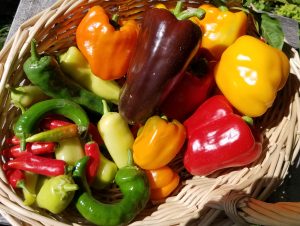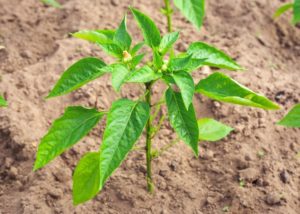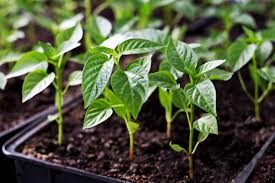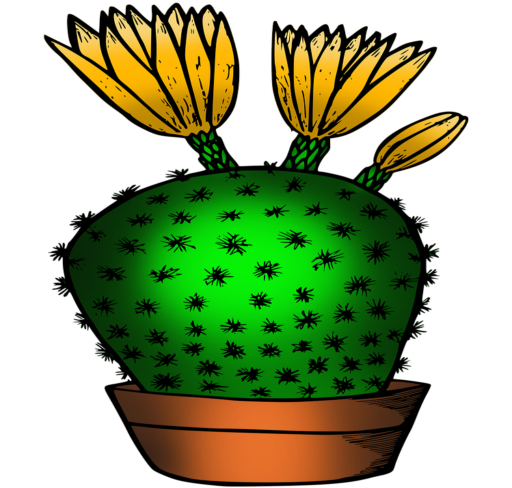
Growing Peppers
- Peppers need a sunny spot in your garden with well-drained soil.
- Water deeply once or twice a week, and mulch around the plant to help retain moisture.
- Peppers also benefit from a balanced fertilizer.
- Harvest the peppers when they are fully ripe for the best flavor.
Planting Peppers Indoors for Seedlings
Only home gardeners who enjoy long growing seasons should attempt to sow peppers seeds directly in the vegetable garden. Most of us must start our own pepper plants indoors about 8-10 weeks before transplanting after the last frost.
Sow seeds ¼ inch deep in seed-starting formula
Keep the soil moist at 75 degrees F
Seedlings emerge in 10-21 days
As soon as seedlings emerge, provide plenty of light on a sunny windowsill or grow seedlings 3-4 inches beneath fluorescent plant lights turned on 16 hours per day, off for 8 hours at night. Raise the lights as the plants grow taller. Incandescent bulbs will not work for this process because they will get too hot. Most plants require a dark period to grow, do not leave lights on for 24 hours.
Seedlings do not need much fertilizer, feed when they are 3-4 weeks old using a starter solution (half strength of a complete indoor houseplant food) according to manufacturer’s directions.
If you are growing in small cells, you may need to transplant the seedlings to 3 or 4 inch pots when seedlings have at least 3 pairs of leaves before transplanting to the garden so they have enough room to develop strong roots
Before planting in the garden, seedling plants need to be “hardened off”. Accustom young plants to outdoor conditions by moving them to a sheltered place outside for a week. Be sure to protect them from wind and hot sun at first. If frost threatens at night, cover or bring containers indoors, then take them out again in the morning. This hardening off process toughens the plant’s cell structure and reduces transplant shock and scalding.

Planting Peppers in the Garden
To get an early start with your pepper plants, cover the prepared bed with a dark colored polyethylene mulch at least a week before transplanting. This will heat the soil beneath and provide a better growing condition for young pepper plants. The mulch will also help the soil retain moisture throughout the season as the pepper plants grow.
Select a location in full sun with good rich moist organic soil. Make sure you did not grow tomatoes, peppers, eggplant or potatoes in the bed the previous year to avoid disease problems.
Prepare the bed by turning the soil under to a depth of 8 inches. Level with a rake to remove clumps of grass and stones.
Peppers should be set 18 inches apart in a row with the rows spaced 2-3 feet apart.
Dig a hole for each plant large enough to amply accommodate the root ball.
Carefully remove the plant from its pot and gently loosen the root ball with your hands to encourage good root development.
Fill the planting hole with soil to the top and press soil down firmly with your hand leaving a slight depression around the plant to hold water.
Use a plant tag as a location marker. This is particularly important if you are trying different varieties. It is very difficult to tell which variety is which from the foliage.
Water thoroughly, so that a puddle forms in the saucer you have created. This settles the plants in, drives out air pockets and results in good root-to-soil contact.
Peppers may also be planted in containers. Use a container at least 18-24 inches wide and deep and use an organic potting mix rather than garden soil.

How to Grow
Keep weeds under control during the growing season. Weeds compete with plants for water, space and nutrients, so control them by either cultivating often or use a mulch to prevent their seeds from germinating.
Mulches also help retain soil moisture and maintain even soil temperatures. This is especially important for peppers as their roots may be easily damaged when weeding, and this can lead to blossom end rot.
Keep plants well-watered during the growing season, especially during dry spells. Plants need about 1-2″ of rain per week during the growing season. Use a rain gauge to check to see if you need to add water. It’s best to water with a drip or trickle system that delivers water at low pressure at the soil level. If you water with overhead sprinklers, water early in the day so the foliage has time to dry off before evening, to minimize disease problems. Keep the soil moist but not saturated.
Note that hot peppers tend to be hotter when they have less water and fertilizer. If they receive plenty of water and fertilizer they may be more mild than expected.
Monitor for pests and diseases. Check with your local Cooperative Extension Service for pest controls recommended for your area.
Try planting pepper plants near tomatoes, parsley, basil, and carrots in your home vegetable garden. Don’t plant them near fennel or kohlrabi. Peppers are very colorful when in full fruit and combine well with green herbs, okra, beans and cucumber fences in the garden bed.
Hot Pepper Seeds – Anaheim Chili, Vegetabl…
Grow heirloom peppers – Anaheim Chili Pepper Seeds – 500 – 2500 ScovillesThe Anaheim Ch… [More]
Harvesting and Preserving Tips for Peppers
Like cucumbers and summer squash, peppers are usually harvested at an immature stage. The traditional bell pepper, for example, is harvested green, even though most varieties will mature red, orange, or yellow. Peppers may be harvested at any stage, but their flavor doesn’t fully develop until maturity. Fully ripe peppers in multi-colors are delightful in the garden as well as in salads.
Cut the fruit from the plant with a sharp knife or pruners leaving a small part of the stem attached.
Sweet bell, pimento and cherry peppers are delicious eaten green but are sweeter and higher in vitamins if allowed to turn bright red before harvest. Some varieties are yellow at maturity or may mature from green through yellow and red.
Hot peppers may be harvested at any stage. Anaheim is usually picked green and cayenne types red.
Bell peppers may be chopped and quick frozen for use in many recipes; sweet cherry and banana peppers and hot cherry peppers are perfect for pickling.
A popular and trouble-free way to store hot peppers is to dry them. String mature red peppers by piercing the stem with a needle and heavy thread. Hang the string in a warm, dry, airy place (not in the sun!) to dry. They can make a colorful kitchen accent. Pull a pepper from the string when you need one. Hot peppers remain hot even after they are dried. Remember that in recipes a little hot pepper can go a long way.
Please note that hot peppers can burn sensitive skin on contact and fumes from grinding or cooking them can irritate the lungs and eyes. When working with hot peppers use rubber gloves and wash your hands before touching your face or eyes.
